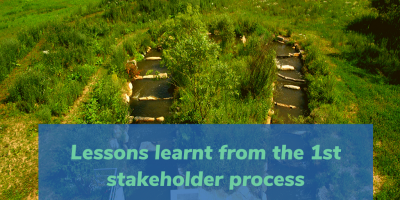Latest News
Lessons learnt from the first wider stakeholder process
HYDROPOWER EUROPE Consultation Expert Panel gathered feedback received from the first wider stakeholder process in order to provide the recommendations concern the Research and Innovation Agenda (RIA) and Strategic Industry Roadmap (SIR). The first wider stakeholder process included the online consultation and the three regional workshops which were held during summer and autumn 2019.
The first expert recommendations after the first expert workshop in March 2019 on the initial structure of the RIA and SIR together with the current status of hydropower technology are summarized in the HYDROPOWER EUROPE report WP3-DlRp-20.
Following the three regional workshops (see HPE Report WP2-DlRp-22), the CEP determined a first categorization of the topics to help in preparing the first draft of the RIA and SIR. For this, key actions include:
− Collecting and pooling the topics for the preparation of the CEP consultation,
− Organising and analysing the CEP feedback.
What is the purpose of the Consultation Expert Panel?
The Consultation Expert Panel (CEP) consists of 34 representatives of the whole hydropower community with a wide range of technical, economic, environmental, legal and social knowledge. The focus of the CEP is, on the one hand, to evaluate the structure and content of the Research and Innovation Agenda (RIA) and Strategic Industry Roadmap (SIR) regarding their application in a consulting process with all stakeholders and on the other hand to analyse and advise on prioritising the comprehensive information based on the overall consultation processes.
CEP recommendations based on the 1st wider stakeholder consultation process
Out of the 34 members of the CEP, six experts commented on the analysis report. A lot of comments included general remarks and comments as well as proposals for topic merging. Additionally, some experts attached supporting documents.
It was noted that for the R&I topics, in general, the budgets and timeframes indicated by the stakeholders show a very widespread. The possibility that the associated R&I activities which the individual stakeholders had in mind were very different was seen as one reason for this issue. However, generally, the respective budget and time frames looked quite realistic.
Considering the statements from the individual working groups of the regional workshops, and particularly for the SWOT analyses, some statements were seen as partly contradictory. For example, some statements are mentioned both in the weaknesses and at the same time in the strengths. Nevertheless, depending on the point of view or perspective a weakness can become a strength.
The final report will be available on the website under the Participant Area.
Latest News
EVENT: Developments and biodiversity of watercourses. 8-10 November 2022
"Aménagements et biodiversité des cours d’eau" (EN: "Developments and Biodiversity of watercourses") is a conference organised by the Societé Hydrotechnique de France (SHF), next 8-10 November 2022 in Strasbourg, France. About the confere...
CONFERENCE: "QUO VADIS? Innovation potential of Hydropower" 27 - 28 October 2022
"QUO VADIS? Innovationspotential der Wasserkraft" (Innovation potential of Hydropower) is a conference organised by IBI- Kompetenz, the multidisciplinary platform for e...
JOINT LETTER: Renewables displace fossil fuels - the Innovation Fund must recorgnise this
Joint letter signed by: Bioenergy Europe, the European Heat Pump Assocition (EHPA), the European Renewable Energies Federation (EREF), the European Solar manufacturing Council (ESMC), the European Solar Thermal Electricity Association (ESTELA), Solar Heat Europe (ESTIF), Solar Power Europe, the A...
ETIP HYDROPOWER EUROPE: The permanent and common voice of Hydropower in Europe
ETIP Hydropower Europe (ETIP Hydropower) is a new project in the EU programme ...
Prof. Anton Schleiss at the 7th IAHR Europe Congress (Greece)
Prof. Anton Schleiss, from the International Commission on Large Dams (ICOLD - CIGB), was invited as a keynote speaker for the opening session og the ...
Hydro Power Industry Guide 2021/22 by VGBE
After the success from "Hydro Power Industry guide 2020/21", our colleagues from VGBe wanted to offer us the new guide from this year: “Hydropower Industry Guide 2021/22”. vgbe´s ...
POSITION PAPER: Hydropower as a catalyst and facilitator for the clean, safe and independent energy transition in Europe.
Key Messages: Given Europe’s ambition to raise the renewables target to 45%1 hydropower is critical to ensure Europe’s energy system has the necessary renewable electricity and flexibility to protect grid stability from intermittent renewable energy, to sustain the gr...
NEW PUBLICATION, Hydroscience Journal: "Hydropower, a catalyst for energy transition in Europe"
On the context of HydroES 2021 (22 September 2021), Hydropower Europe had the chance to present its vision and results achieved during three years of consultations. Some of the conclusions are: Hydropower still has a great potential for development Hydropower sector needs...
HYDRO 2022 Strasbourg: How to promote future hydro development in Europe with a sustainable impact?
The HYDROPOWER EUROPE project (2018-2022), funded from the European Union's Horizon 2020 research and innovation program, has released its final deliverables: a Research and Innovation Agenda (RIA) and a Strategic Industry Roadmap (SIR) for the hydropower sector. The challenge is...
Webinar 28 february 2022: What Research and Innovation are Needed to Tap More Hidden Hydro Opportunities in the Future?
The IEA Technology Cooperation Programme (TCP) on Hydropower (also known as IEA Hydro) is a working group of the International Energy Agency's member countries and others that have a common interest in advancing hydropower worldwide. Under the work programme Annex XVI...





